Four years ago next month, a $1 million slice of the federal economic stimulus package started leaving its mark on Portland: 2,100 durable thermoplastic sharrow decals, intended to greatly increase the visibility of the city’s new neighborhood greenway network.
Now, as the city’s fog seal street maintenance efforts have been covering up sharrows, the city faces its first big decision about this bit of bike infrastructure: how to maintain them?
The good news is that the city is “committed to maintaining sharrows in good working order,” spokeswoman Diane Dulken said this week. “They could be thermoplastic, they could be paint, or they could be modified paint with extra beads for reflectivity.”
If they choose paint over thermoplastic, they plan to retouch the paint every year or two.
“As a rule, we paint our [bike] markings about once a year, but with sharrows they may have a longer lifespan — we’re thinking between one and two years — because one of the factors is traffic,” Dulken said. On lower-traffic neighborhood greenways, she said, painted sharrows will probably last longer than bike lanes along busy streets.
Sharrows are a very common bit of bike infrastructure in other U.S. cities, where they’re often used to mark a supposed bike route on the rightmost lane of a major street without forcing the city to actually devote street space to biking. In Portland, though, they’re placed down the middle of quiet neighborhood streets, and their double chevron arrows sometimes serve as wayfinding tools when a greenway jogs right or left:
Another city that uses sharrows on low-traffic streets is Vancouver BC, the city whose bike boulevards inspired Portland’s neighborhood greenways. When I was there last fall, the poor visibility of their painted sharrow markings was one of the few ways in which their network was inferior to Portland’s. I often struggled to see, as I passed perpendicular to a street, whether or not it had sharrows. Faded ones like this seemed common:
It’s great to hear that the city is committing to better maintenance of these markings that are uniquely important to our bike network. With the right care, this can be part of the federal stimulus package that keeps on giving.


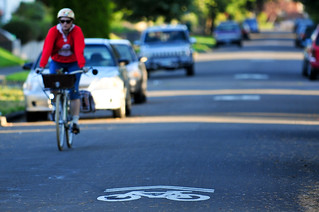
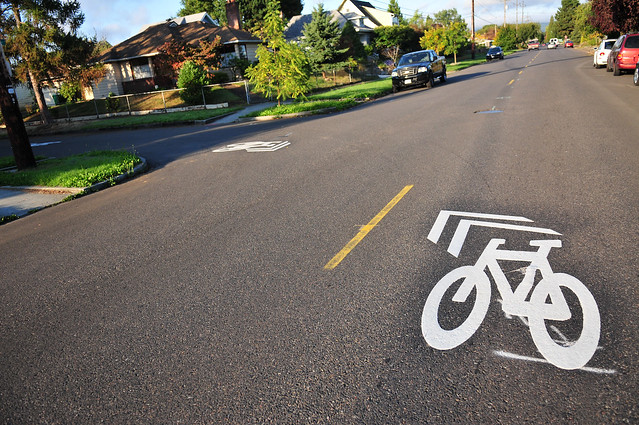
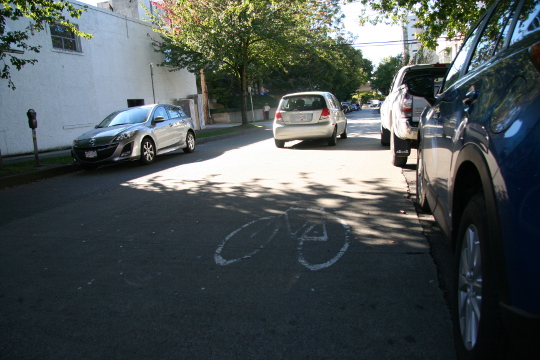
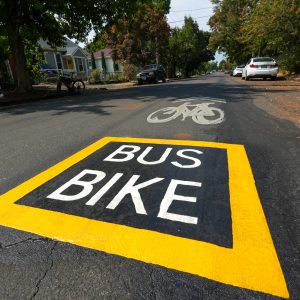
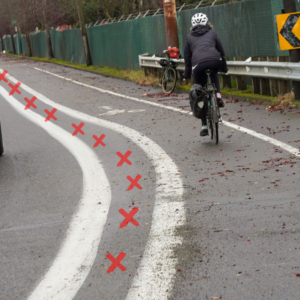
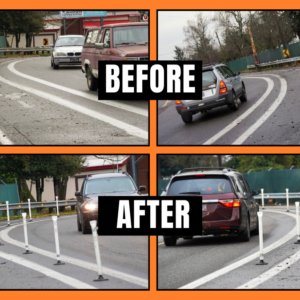

Thanks for reading.
BikePortland has served this community with independent community journalism since 2005. We rely on subscriptions from readers like you to survive. Your financial support is vital in keeping this valuable resource alive and well.
Please subscribe today to strengthen and expand our work.
paint please! the thermoplastic is too think and makes for a bumpy ride…
Seriously?
He’s running 18mm tires at 150psi.
35mm at 70psi…
I even hate running over crosswalk lines… although if bombing an intersection the worst part is usually the tire ruts from the cross-street…
I ran over a shadow and it threw out my lumbago
I once saw an elephant in my pyjamas…
They are rather jarring on my boneshaker velocipede running wooden wheels and iron tires.
I’m gonna agree and say that the thermoplastic is bumpy, but disagree and say I prefer it overall because of its longevity. If it’s painted and fades away, that doesn’t do me much good at all. I have that experience with many bike lanes (such as the bike lane on Sandy at the Banfield onramp, which fades out about every year around this time).
Paint doesn’t seem to work very well in Portland. Just take a look at SW Oak’s green paint–it’s so faded I can’t even get annoyed when cars drive up the bike lane anymore.
Any idea about if PBOT is working on installing more wayfinding signs on our Greenways? I find them extremely helpful, and I wonder why there aren’t a lot more of them. It seems like many were installed as the Greenways were getting Sharrows, then adding more signs tapered.
Very perceptive. The ARRA funds paid for sharrows and signing. The greenways that came after did not include regular guide signing.
I agree that the thermoplastic is too thick and I generally go around the sharrow markings.
And paint would last a whole lot longer if studded tires were banned.
Sharrows are generally placed between wheel paths, when possible, so wear is not a common reason they disappear. Sunlight degredation is the most common reason.
Thermoplastic is really the best option and seems to last longest (as long as it is properly applied). Hopefully any version of the material used is also a bit grippier than some of the previous iterations. Definitely integrating the sharrows with wayfinding is one of the better appropriate uses. While they are at it, it would be great to redo the stop bars along the bike boulevards to further delineate their priority.
The new set of thermoplastic markings has skinnier line width than the original ones. They are wearing off faster. See the 12th Ave overcrossing.
The new set is what the FHWA specifies per the MUTCD.
Isn’t using sharrows for wayfinding a misuse of the symbol? Maybe we should use sharrows as sharrows, and replace some of our wayfinding sharrows with the smaller, round, bike + arrow markings. Could paint be applied in a position less likely to be rolled over by car tires? Although that might mean moving the stencils out of the door zone (as appears in the third photo above).
Out of curiosity, are sharrows anything other than a timid suggestion that drivers lay off their horns when behind a cyclist on a sharrowed route, or do they confer some different legal standing to cyclists on such a route (as would be the case with a bike lane)?
I haven’t seen any new sharrows in the door zone… on narrow streets the sharrows for both directions are in a single line in the middle of the road…
They are said timid suggestion, plus indicate where bicyclists should position themselves in narrow roadways (which is why I personally prefer paint to slippery, bumpy thermoplastic – yes, I run 23s @ 130lbs). They’re not indicated in MUTCD for wayfinding, as you correctly point out. They’re actually most effective when used with a green wave and/or augmented with “Bikes May Use Full Lane” signs (oh, and among an educated motoring public).
The FHWA specifies the size, shape and use of traffic control devices in the Manual of Uniform Traffic Control Devices (MUTCD). Seattle is currently inquiring about directional sharrows, since it appears the FHWA did not anticipate their use on low-volume roadways, but more as a positioning symbol on higher volume roads and wide lanes. Except at the trial locations, like NW 18th and 19th, Portland has consistently used them to alert motorist to expect cyclist and as guidance for cyclists. Those guide signs are small after all.
I’d prefer to see white “stop lines” at every stop sign in the city.
and enforcement of them…
Until cars position drivers much closer to their front bumpers, stop lines will continue to be worn away by drivers stopping “at” stop signs…
Stop lines serve a purpose yet still. They reinforce the mere presence of the stop condition. I see many drivers blow through stop signs where no line is present. Any time I’ve been able to point it out, they claimed to have missed seeing the sign. Honest mistakes are made. I’m all for a redundant control device.
Driver behavior is more complex than that. The limited studies conducted find a large portion of all road users do not actually stop at stop signs, when in an ideal ‘vision zero’ world, all road users would comply with traffic control. I suspect drivers that don’t stop at stop signs do so because it is a low-speed situation and/or the visibility is such that they can clearly see there are no conflicts. Much of the issue is the gap between rational intersection use and the legal tools available. The MUTCD makes it very difficult to use YIELD signs, when, in most cases, YIELD signs would be more than sufficient to assign right of way. And that is all the signs do, assign right of way – lable who is to blame if a crash occurs. Signs don’t stop any one, never have, never will.
We absolutely agree – your points are spot on, especially in that signage and road marking should go hand in hand because neither seems to be as effective on its own.
“Stop” is a complex thing, for sure. Studies show that motorists tend to stop beyond stop lines, primarily due to lining up their field-of-view (and to a lesser degree the sheer mass of a car in motion). Bicyclists, as I suspect we all know, tend to stop behind stop lines to maintain just enough momentum to balance while looking for traffic, and then roll through the line when clear (hence the appearance to some as the cyclist not actually stopping). And this is just documenting the behavior of those who are trying to be compliant…
(Sorry, don’t have the reference handy).
I’d be happy if they would put the sharrows in better spots so they could be used as way finding themselves. A number of places I’ve “lost the trail” because the sharrows are about 15 feet from the intersection, and other times can’t find the bike blvd in the first place.
I’d show you the new wayfinding markings we use in Santa Clara, CA, but street view isn’t up to date. The good thing is that they’re easily recognizable (for linking a dedicated MUP through on-street bike lanes to the continuation of the MUP). The bad thing is that (for now) very few people actually know that’s what the “blue and white wavey things” are for.
Roger Geller is working on updating the sharrow marking guidelines to make them more helpful. Policy has already been adopted, and retrofits to the ARRA sharrow paths are taking place. ARRA sharrows had to be installed per FHWA rules.
Vancouver, BC, does not use sharrows on neighborhood streets, only on major streets. It does, however, use bicycle symbols and regular arrows.
Another option to making the thermo bike sharrows less bumpy and more visible (higher contrast) would be to install them as a panel (white thermo on black thermo background)…thus there would be only two surface edges to traverse vs. 6+.
LOGOTHERM (Brix Paving/ local resource)
http://www.lmpaving.com/logotherm/brochure.pdf
This would raise the per unit cost but may lengthen their lifespan.
This would also improve the contrast when sharrows are installed on concrete streets, as white stencilling washes out into the background surface once it gets dirty and in the winter months.
Route out asphalt in the shape of the sharrows and pour in concrete.
Perfect (if you meant “rout”). I am imagining increasing thickness of additional layers of thermoplastic, and shuddering. But what happens when a layer of sealant is put over the concrete? Could it be pushed off immediately?
Couldn’t remember the correct spelling, Thanks
What happens when the road is milled and an overlay installed? Your proposal is more expensive than the current solution.
After surface milling and more fresh asphalt is layed down but before it is smoothed with the steam roller lay down an not-hollow cookie cutter shape of the sharrows that is about 2″ thick.
Steam roll into asphalt surface so it is flush.
Allow to cool.
Remove cookie cutter stencil.
Pour in concrete flush with road surface.
It occurred to me as I wrote this that the current thermoplastic sharrows could be steam rolled flush in to an asphalt resurfacing.
If the new road surface is concrete you can use the same technique as is used in cake baking to make a single layer cake of 2 different wet batters.
A divider is placed in the pan/road.
Main pour on one side and different pour on the other.
In the case of cake batter and concrete the difference could just by coloring.
You could also pour green tinted bike boxes and lanes.
Check into the cost of those and get back to us. DuraTherm is one brand.
Rolling thermo into hot asphalt is how the bump markings are done, and they are very durable.
What do you mean by “bump markings”? Are you considering the sharrows to be bump markings?
How are the current thermoplastic sharrows applied in Portland? I followed the DuraTherm name (thanks for the product name) to a product that is applied almost exactly how I described. The product is supposed to be flush with the road surface. Given the consistent complaints that we have about thermoplastic installations in town I’m thinking PBOT isn’t doing it right.
More digging on the site with DuraTherm (http://www.decopavement.net/?page_id=101) shows that the DuraTherm isn’t offered in bike patterns.
The sharrows pattern (http://www.decopavement.net/?page_id=357) seems to be applied with a propane torch. The advantage is spun as allowing installation all year round without requiring heating of the asphalt substrate. The disadvantage of this is that the product will never be embedded in the road surface if you follow the installation instructions.
I expect that the “PreMark Bike Lane Markings” sharrows pattern could be installed like the DuraTherm; if it can survive a propane torch for installation the lower temperature of a steam roller.
DuraTherm is made by Ennis-Flint.
It seems they also make the sharrows marketed as PreMark.
In fact if you look through their “Preformed Thermoplastic Brochure” it looks they are writing PBOT’s playbook for surface treatments of every variety.
Getting prices will involve falsely portraying myself as a governmental or large commercial entity. It might be easier just to ask PBOT to show us the price list.
…I guess another of my technical comments got “moderated” away, since is gone.
I would post the list of words that the comments system auto-moderates on but….
Also certain commenter’s screen names. In particular the more controversial commenters.
q’Tzal,
you’re right! I do have certain commenters that are on the blacklist. That means I read all their comments before they are published. People get on the blacklist by being mean or just by making me generally nervous with their tone. I don’t have time to babysit people, so if I feel someone is out of line and pushing the boundaries I will just either delete their comment entirely or put them on the blacklist.
And yes, there are also a long list of words that will get your comment auto-moderated.
But beyond that I discovered that if I merely include the screen name of any of 3 infamous commenters IN MY comment it gets bounced as well.
Out of morbid/geeky/scientific curiosity I went to a very old article on this website with non-controversial topic & a low comment count and fed it lorem ipsum with test words.
You have a the most stringent comments filtering I’ve encountered anywhere. It is so stringent I wouldn’t have been surprised if “helmet” or “vehicular cycling”
I agree wholeheartedly that you have every right and responsibility to moderate the comments on YOUR website. It would be nice to have a little transparency in the commenting rules instead of just “error”.
Security by Obscurity is no security at all. I haven’t shared anything I’ve found because I respect your authority here but still think there is room for improvement.
Thank you for your time.
Checked our queue and didn’t see it, Todd – maybe rephrase?
Todd’s comment got captured by our spam filter. That happens from time to time. I found it and just pushed it through. I know it can be annoying/frustrating when your comments get auto-moderated, but I can assure you that there is no vast censorship conspiracy afoot. Thanks for the comment Todd.
Another reason for 42s at 40psi….
Schwalbe Big Apple” tires available up to 60-622.
Or Surly Bikes Black Floyd which clocks in at 93-107mm wide depending on rim width.
Put sharrows on the main streets where bikes are supposed to share a lane with autos, like Hawthorne which has signs indicating bikes may be in the lane but no symbols on the street that proclaim this, and come up with some other symbol on the neighborhood greenways (or whatever they’re calling them this week).
In other words, increase by 1/3 the number of symbols used for bike pavement markings? I prefer simple and two symbols (sharrow and bike lane) are plenty.
imo, the use of sharrows on bike boulevards was intended to undermine their utility on arterials and commercial streets. the “8/80” crowd is vehemently opposed to anything that mostly helps “experienced bike commuters”.
I’m curious how you arrived at ‘intent’.
when a symbol that has always been intended to mean “bikes may use full lane” is instead used to designate wayfinding i don’t think it’s a stretch to argue that the staffers at pbot understood that they were undermining the original use. it’s also no secret that pbot staffers are now reluctant use conventional sharrows on arterials because they may cause “confusion”. i also remember when both geller and his predecessor (mb) were aficianados of sharrows.
It is PBOT Traffic Operations Chief Engineer Rob Burchfield who refuses to use sharrows as intended.
No plows there, right? I think I’ve seen thermoplastic where a plow caught it and peeled half the sharrow off the road.
More likely an installation on too moist or cold of pavement. both paint and thermo need warm weather for longevity of the results.
Someone with the bike program – Greg Raisman? – told me that Portland tries to position sharrows in the center of where cars actually travel in the lane. On narrow streets, that’s why they seem to run down the center of the road.
I believe they are placed to indicate the safest riding position. I ride down the middle of most Greenways, but I still see a lot of people who hang right in the parking lane. I’m not sure how to tell them it’s not safe without seeming like a backseat rider. My experience with cars running stop signs suggests that people riding far to the right are vulnerable. The last minute brake slamming “oh sorry I didn’t take the stop sign seriously” drivers are merely embarrassed when they almost hit me, but if I’d been hugging the curb it would be a lot worse.
I’m told there’s been a shift in thinking (and guidelines) of where they should be placed. Here in California the old guidelines were 1/3 of the way into the traffic lane, but the latest guidelines have them centered in the traffic lane. (At least that’s what’s been explained to me by our city traffic engineer, and he said it also improves the longevity of painted treatments as they’re not worn by cars so quickly).
The reinstallation of the sharrows on the fog-sealed streets was done it a way that makes them even more of a bump. The new ones were installed exactly over the top of the old ones, giving a double-thickness bump, rather than placing them three feet further down the street!
It costs less to keep track of where all the markings are if you put them back in the same place every time.
…seems to me like you keep offering up standard ‘can’t do’ bureaucratic responses to any and all suggestions for improvement…
The higher the cost to add facilities to the system, the fewer improvements get done. Call it what you will, but the funding is limited. Even if we had a dedicated stream of taxes, wasting them is poor management. Seems like bureaucrats get slapped no matter what they do.
2 layers of thermoplast, sure. But 6 layers? Problem.
At what point do ya’all figure the later buildup becomes uncomfortable?
Seismometer app test, anyone?
When someone’s jimmys get rustled.
Comfort is a matter of personal preference and so cannot be empirically tested. No matter what someone will complain.
There is no obvious way to execute a double blind study go test this. A rider has to be aware with eyes open and thus will apply their internal biases to any easy testing regime.
Maybe you could put down test stripes (on an off street path) and after the test area a big sign with two (or more) rounded crosswalk buttons allowing cyclists to select a reply to a question on the sign without ever stopping. Maybe a box underneath with paper survey forms for the truly dedicated to discourage repetitive button presses.
Paint please! I get where people are saying bumpy and yeah, whatever – that’s annoying, but what truly is annoying is the deathly fear almost every single morning of my winter commute worrying about breaking a bone not because of any driver/traffic, but because of the very road I am riding on. And because of the g-d thermoplastic! I am so tired of slipping on the frosty, icy crosswalk thermoplastic lines and other markings – that feeling of having my bike pulling out from under me. (And by the way, I don’t ride with hipster wheels.)
I think it is possible to get thermoplastic with embedded grit. I say this because there is a cycletrack in Cambridge where they have huge carpets of green thermoplastic (I checked) to indicate where bicycles intersect bus stops, and they don’t seem to be slippery like crosswalks, and the size that they are, I think I would have noticed (I can check again by hand). I took a picture the other day to illustrate wear from plowing (plowing on a cycle track, not a road) in just a few years: https://flic.kr/p/m5u6Pk
One advantage of thermoplastic lane markers is that when they’re wet, your rolling resistance goes down a bit. Gives you an incentive to practice riding a very straight line.
the thermoplastic here does have embedded grit but after a few years of being ridden on by motorists it’s as smooth as baby buttocks. and when it’s wet it’s like riding on black ice.
I noticed coming back from Salem this week that there are thermo plastic lane stripes that are coming off like crazy. Strips of tape all over the place.
What a waste of money.
Bkes could ride on these streets before, it doesnt change anything. They didnt gain any new rights.